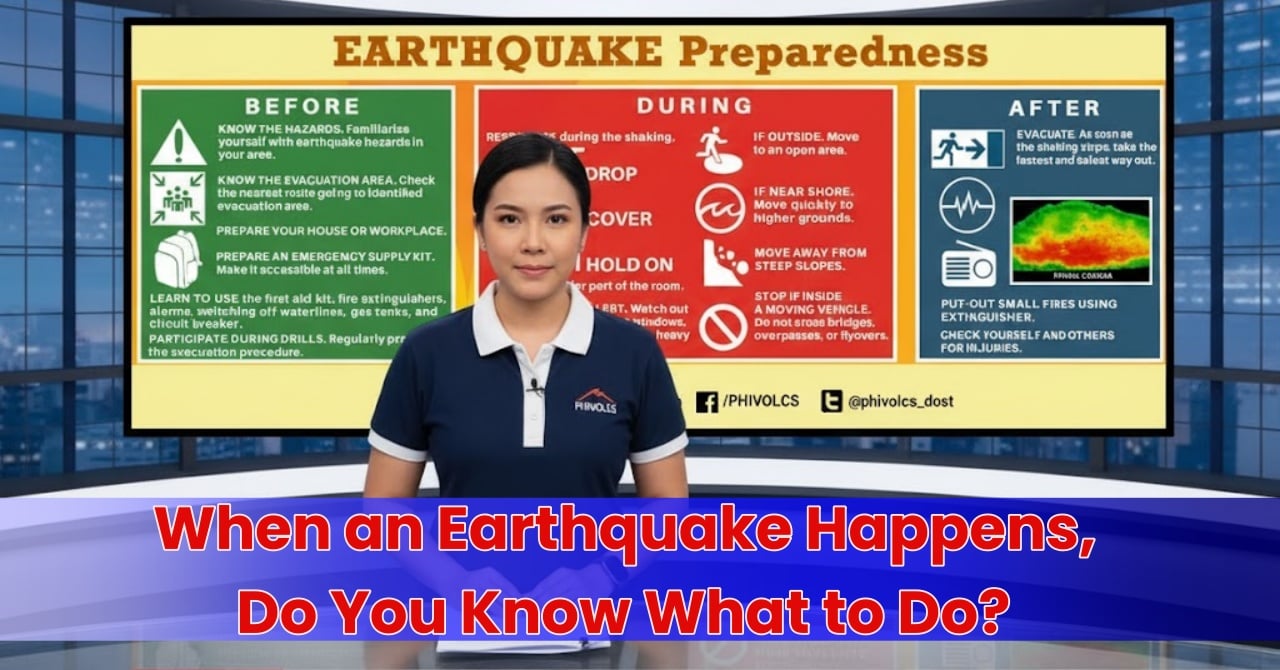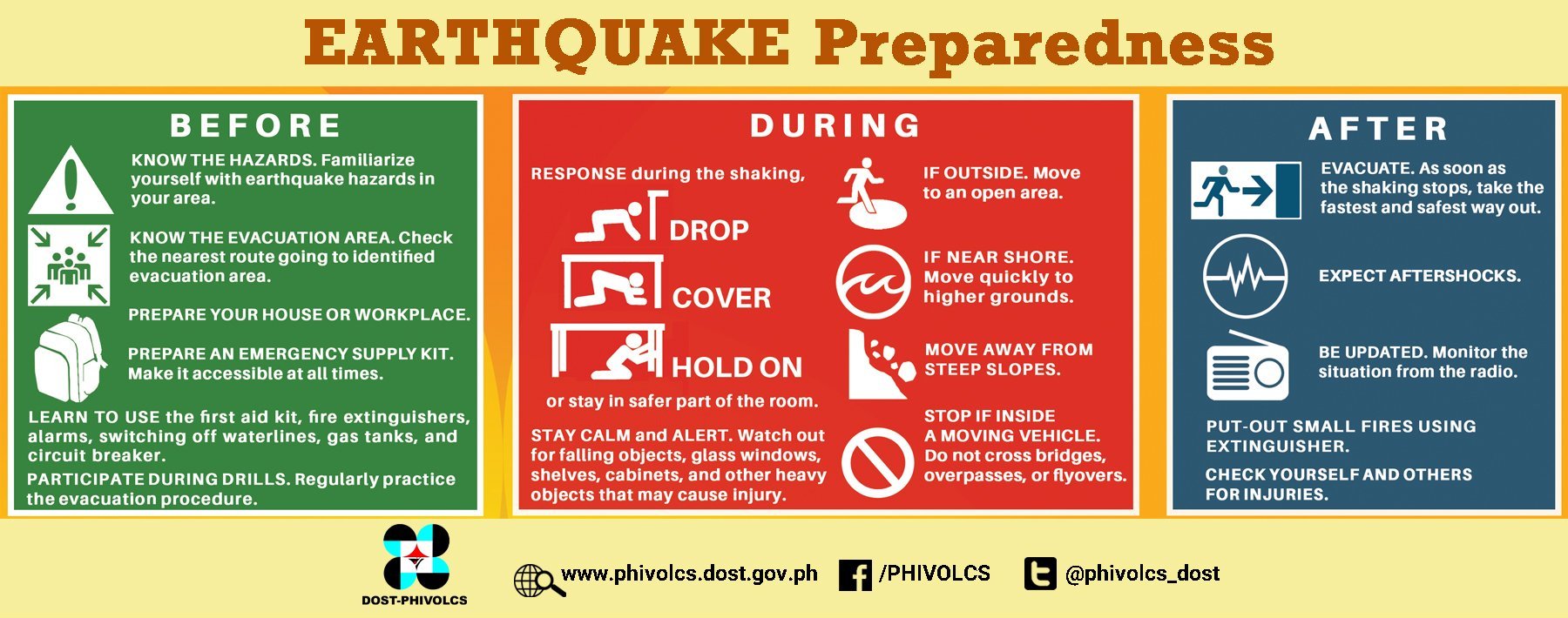When the ground shakes, every second counts. Recent earthquakes in Mindanao and neighboring countries such as Taiwan and Japan have underscored the importance of preparedness across the region. These events serve as a reminder that the Philippines, located along the Pacific Ring of Fire, remains highly vulnerable to seismic activity.
To help Filipinos stay ready and resilient, PHIVOLCS released an official Before–During–After earthquake framework, offering clear and practical steps to follow at home, in school, or in the workplace. Let’s take a look at it and be informed.

BEFORE an Earthquake (Preparedness)
Earthquake safety starts long before the shaking begins. Knowing your risks and preparing early can save lives.
- Know the hazards in your area – Check if you live near fault lines or tsunami-prone zones using PHIVOLCS’ online maps. Awareness helps you plan evacuation routes early.
- Identify evacuation areas and safe routes – Learn where to go and how to get there. Familiarize yourself with nearby open spaces.
- Prepare your home or workplace – Secure heavy furniture and appliances that could fall. Check walls for cracks or weak spots.
- Pack an emergency supply kit – Include water, canned food, flashlight, whistle, first aid kit, medicines, and batteries. Keep it accessible.
- Learn to turn off utilities – Know how to shut off your home’s gas, electricity, and water lines to prevent fires or leaks.
- Join regular earthquake drills – Practice builds reflexes. Participate in community or school drills to strengthen your response habits.
Pro tip: Label your emergency bag clearly and store one per family member. Don’t forget your pets’ needs, too.
DURING an Earthquake
The moment the ground moves, every second counts. Staying calm and following the right actions can make all the difference.
When Indoors
- DROP, COVER, and HOLD ON – Take cover under sturdy furniture like a desk or table and hold on until the shaking stops.
- Stay away from windows and glass – Shattered glass can cause serious injuries.
- If in bed, stay there – Protect your head with a pillow instead of running.
- Never use elevators – Power may cut off suddenly, trapping you inside.
When In High-Rise Buildings
- Keep calm and stay put – Avoid rushing to exits while the building sways.
- Move away from windows or shelves – Take cover beside interior walls or sturdy furniture.
- Brace yourself – Hold onto a stable surface until the tremor subsides.
When Inside a Car
- Pull over to a safe open area – Stop away from bridges, trees, or power lines.
- Keep your seatbelt fastened – The car provides protection against falling debris.
- Turn on hazard lights – Stay inside until shaking ends, then listen for radio updates.
When In Public Places
- Stay calm and don’t rush – Panicking can cause stampedes.
- Protect your head and neck – Use your arms or bags as shields.
- Follow staff instructions – Security and safety teams are trained for these situations.
When In Schools
- Duck, cover, and hold under desks – Keep your head down and face away from windows.
- Wait for teachers’ signal before evacuating – Moving too early can expose you to falling objects.
When Inside Trains (MRT/LRT/PNR)
- Hold the handrails tightly – Trains may stop abruptly.
- Stay inside until given the all-clear – Exiting unsafely can be more dangerous.
When Outdoors
- Move to an open area – Avoid trees, power lines, and tall buildings.
- Stay alert for falling debris – Keep your eyes up and head protected.
- If near the shore, go inland immediately – A strong quake near the coast may trigger a tsunami.
AFTER an Earthquake
When the shaking stops, it doesn’t mean the danger is over. Aftershocks and damaged structures can still cause harm.
- Evacuate calmly – Avoid elevators and check surroundings before moving.
- Expect aftershocks – Stay alert and ready to take cover again.
- Check for injuries – Provide first aid if you’re trained.
- Put out small fires – Only if it’s safe and manageable.
- Listen to official advisories – Follow updates from PHIVOLCS, NDRRMC, or your local DRRMO.
- Avoid the coast if tsunami warnings are raised – Wait for official clearance before returning.
- Inspect your home – Look for cracks, gas leaks, or unstable walls before re-entry.
- Help others responsibly – Lend aid but prioritize your own safety first.

Final Thoughts
Earthquakes can’t be predicted, but they can be prepared for. Every drill, checklist, and simple precaution adds a layer of protection. Whether you’re a student, a worker, or a parent, readiness is everyone’s responsibility. Stay informed, stay calm, and stay safe.
Frequently Asked Questions
- How often should earthquake drills be done?
At least twice a year. Schools, offices, and local governments usually organize the “Shake Drill” through NDRRMC or PHIVOLCS. - What should I put in my emergency kit?
Essentials include bottled water, canned food, flashlight, batteries, whistle, first aid supplies, medicines, cash, and IDs.
3. How can I report damages or request assistance?
Contact your local DRRMO or barangay. For major incidents, follow updates and report through the PHIVOLCS or NDRRMC hotlines.
